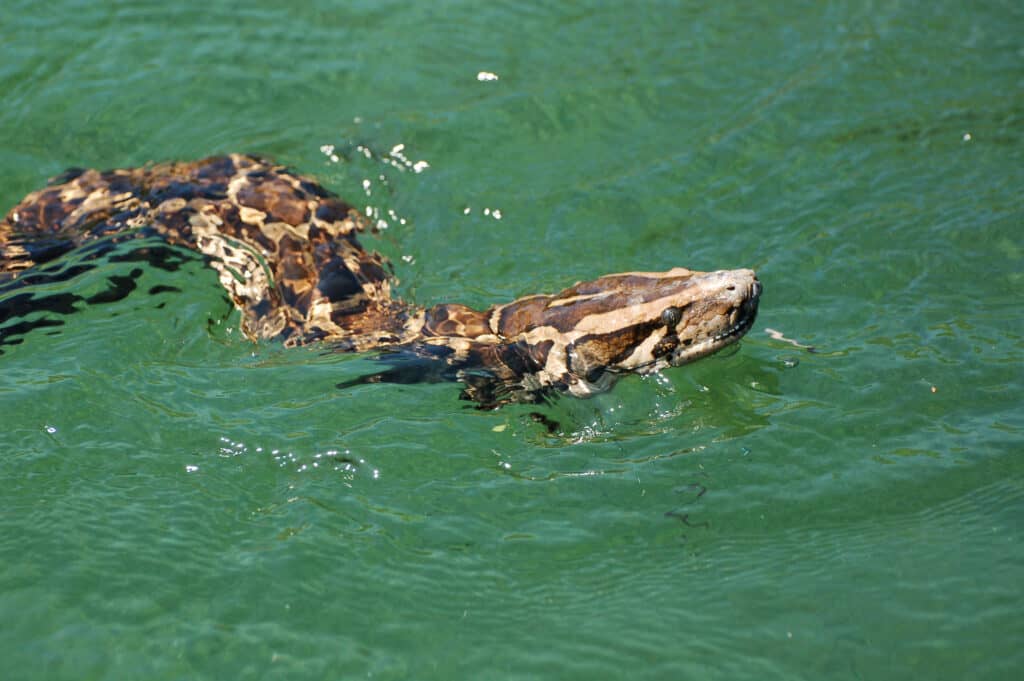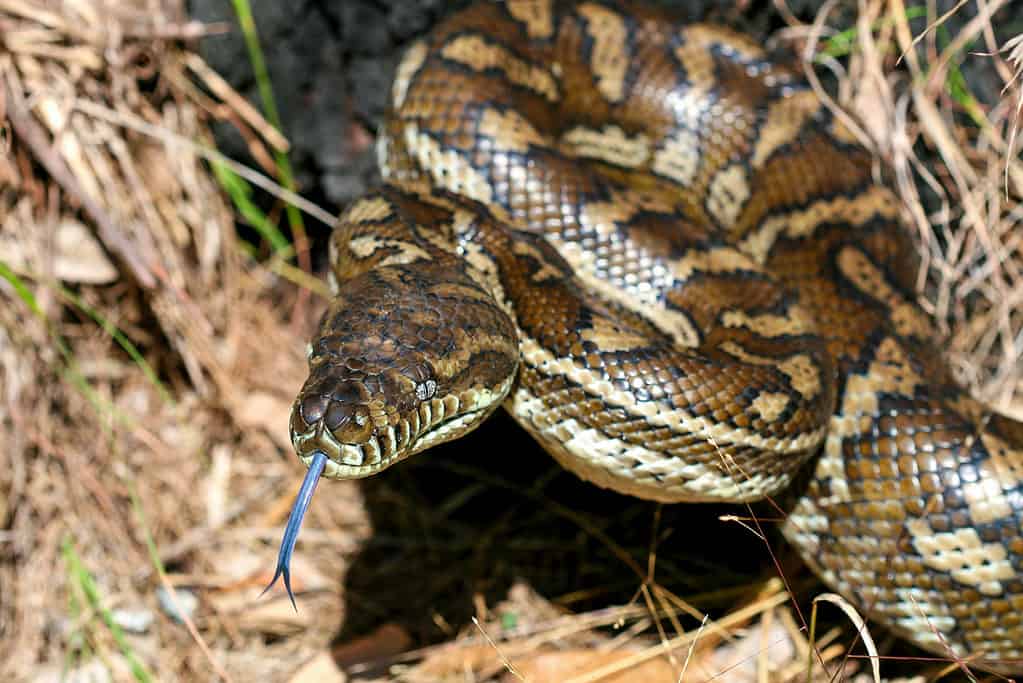Who do you think would win a fight between a python and a crocodile in Florida?
Generally, we would look to real life examples for clues, but surprisingly, there isn’t very much of that. While there are a few examples of pythons getting into it with alligators in Florida, they don’t seem to have many significant interactions with crocodiles.
This doesn’t mean that we can’t wager a pretty good guess on our own, though. We can actually take a look at pythons and crocodiles in Florida and see who would emerge victorious in an encounter between them.
Let’s dive in!
Pythons: An Invasive Species in Florida

The
Burmese
python is an invasive species in Florida that has upset the balance of the ecosystem.
©Heiko Kiera/Shutterstock.com
The Burmese python is not a native species in Florida. However, they are found often around the Everglades in South Florida. Native to Southeast Asia, Burmese pythons were first brought to the United States as exotic pets. Some pet owners ended up releasing the snakes into the wild, and the problem began.
The Burmese python is now considered to be a nuisance to the Everglades ecosystem, and for good reason. These pythons compete with native animals for food. They have also caused severe declines in many native species, including bobcats, opossums, and raccoons.
Some species, such as foxes, marsh rabbits, and cottontail rabbits, have almost completely disappeared because of pythons.
In fact, they’ve even been known to eat alligators in some cases. In 2005, in the Florida Everglades, the body of a Burmese python was found with an American alligator in its stomach!
Crocodiles in Florida

The American crocodile, or Crocodylus acutus, generally populate South Florida. This is the northern end of the crocodile’s range in most cases. They can be found in coves, ponds, and creeks in mangrove swamps, and they typically inhabit saltwater or brackish areas.
Floridians will often see crocodiles basking in the sun. Because they’re ectothermic animals, they rely on external heat to regulate their body temperatures.
They are the largest reptiles on earth and are said to be able to produce tears. They can’t chew their food and to improve digestion they have been known to swallow rocks. Crocodiles also have special hearts. Their hearts have four chambers just like humans do!
Shy and reclusive, they’re generally not a danger to people. If they’re approached by a person while basking in the sun, they’ll usually just quickly escape into the water.
American crocodiles typically eat small mammals, frogs, fish, turtles, and birds. Humans are the main threats to crocodiles, because of habitat destruction and illegal hunting.
Crocodile nests are also in danger due to predators, such as birds, crabs, and raccoons. In some cases, pythons will even eat alligator and crocodile eggs.
Where Do Pythons and Crocodiles Live?
Pythons live in tropical areas of Asia and Africa. They can thrive in either wet or dryer environments, however they are freshwater and fully marine. They like it where it is hot and wet so their bodies can stay warm. They are usually found in rain forests, woodlands, grasslands, swamps, and shrubs.
These types of environments are home to many different creatures such as the crocodile. That’s why these creatures are natural enemies because they share the same waters and wetlands.
How Long Do Pythons and Crocodiles Live For?
If a Ball Python are able to survive adulthood, they can live about 10 to 15 years in the wild. However, the expected lifespan for a ball python living in captivity is around 30 years old. Some however, have been recorded to live over 50 years old when cared for properly.
Python vs. Crocodile
| Python | Crocodile | |
|---|---|---|
| Size | Can be up to 26 feet in length and 200 pounds in weight. Average length in Florida is 8 to 10 feet. | Can be 10 to 20 feet in length and between 300 and 2,000 pounds in weight |
| Speed and Movements | 1 mile per hour, slithers in a straight line (rectilinear locomotion). Can also swim and stay submerged under water for up to 30 minutes. | Moves in a galloping motion and can run up to 20-25 miles an hour in some cases, but only over very short distances. |
| Senses | Typically have poor eyesight but can stalk prey using heat sensors in their jaws and chemical receptors in their tongues | Strong senses of smell, have adapted to seeing in the dark, well-developed hearing, and integumentary sense organs that make them very sensitive to changes in pressure. |
| Defenses | Large size and ability to effectively camouflage themselves | Large size, ability to whip their tails, adaptations that allow them to conceal themselves underwater. |
| Attack Abilities | Sharp, rear-pointing teeth; ability to constrict prey with 14 PSI power (measured using a 5.5-meter python) | Can close their jaws with 3,700 PSI of bite force, 60 to 70 curved, conical teeth |
| Offensive Capabilities | A painful bite that is not venomous and usually not fatal, ability to constrict prey | The strongest bite ever measured in a living animal |
| Predatory Behavior | Generally strikes at attackers, bites them, and holds on to prey while constricting and writhing. | Usually launches a surprise attack from the water or the edge of the water |
The Key Factors in a Battle Between a Python and Crocodile

When two apex predators do battle, who will win?
©iStock.com/oshun
When predicting who would win in a battle between a python and a crocodile, we need to consider all of the factors. Knowledge of the physical features of both of these animals is very helpful in this process.
Python vs. Crocodile: Size
Pythons are often longer than crocodiles, reaching up to 26 feet long, while crocodiles usually aren’t more than 20 feet long. However, crocodiles do have the size advantage, as they tend to be much heavier. While a python is typically no more than about 200 pounds, a crocodile can be up to 2,000 pounds.

Close up of carpet python with its tongue out
©Michelle Marks/Shutterstock.com
Crocodiles have the size advantage over pythons.
Python vs. Crocodile: Speed and Movements
Both pythons and crocodiles have the ability to stay submerged under water for stretches of time. However, crocodiles are much faster, being able to run up to about 25 miles per hour in some cases. Pythons only slither at about one mile per hour. Even if crocodiles can only run for short distances, they can easily catch up to a python in most cases.
Crocodiles have the speed advantage over pythons.
Python vs. Crocodile: Senses
Pythons do have the ability to use heat sensors and chemical receptors to stalk their prey. However, they typically have poor eyesight. Crocodiles have better eyesight and are able to see in the dark. They have strong senses of hearing and smell, as well as the ability to sense even subtle changes in pressure.
Crocodiles have keener senses than pythons.
Python vs. Crocodile: Physical Defenses
Pythons and crocodiles are both relatively large animals, although crocodiles are significantly larger. Pythons can camouflage themselves fairly effectively. Pythons and crocodiles both have the ability to submerge themselves underwater.
In terms of physical defenses, it’s a tie between pythons and crocodiles.
Python vs. Crocodile: Offensive Abilities
Both pythons and crocodiles are known for surprise attacks. Pythons have sharp teeth and the ability to constrict their prey with their bodies. Their bite is painful, but they’re not venomous, and it is not a strong enough bite to be fatal in most cases. Crocodiles, on the other hand, have the strongest bite ever seen in a living animal.
Crocodiles have the advantage over pythons when it comes to offensive capabilities.
The Winner in the Battle Between Pythons and Crocodiles in Florida

Crocodiles are bigger and faster, with stronger offenses and keener senses than pythons; in a battle between a python and a crocodile, the crocodile would likely win.
©iStock.com/AppleZoomZoom
Given the vital stats of both competitors in this fight, we’d have to say that in an encounter between a python and a crocodile in Florida, the crocodile would probably be the winner.
Of course, pythons are not completely powerless. If they’re able to get past a crocodile mother and eat crocodile eggs, they can prevent crocodiles from even getting to the fight in the first place.
Pythons can clearly hold their own, which is why they are so successful as an invasive species in Florida. But given the size and strength of the crocodile, it would likely be no contest between the two. Perhaps at some point, we’ll see evidence of crocodiles helping to control this invasive species.
Is it Normal for Pythons and Crocodiles to Fight?
The simple answer here is yes. The python lives in an aquatic type habitat and while swimming it is vulnerable to attack. This means that if a python is in the water, it is within perfect striking conditions for crocodiles. While younger snakes can be captured and eaten more easily by a crocodile of any size. The older python the larger it gets, so depending on the age of the snake the crocodile may not attack.
The photo featured at the top of this post is © iStock.com/AppleZoomZoom
Discover the "Monster" Snake 5X Bigger than an Anaconda
Every day A-Z Animals sends out some of the most incredible facts in the world from our free newsletter. Want to discover the 10 most beautiful snakes in the world, a "snake island" where you're never more than 3 feet from danger, or a "monster" snake 5X larger than an anaconda? Then sign up right now and you'll start receiving our daily newsletter absolutely free.
Thank you for reading! Have some feedback for us? Contact the AZ Animals editorial team.







